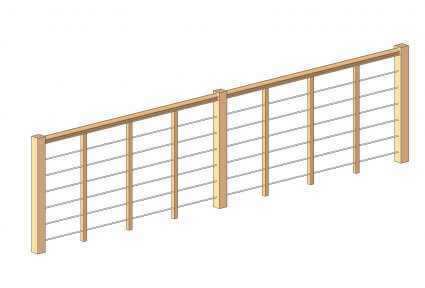When to Use a Guardrail vs. a Handrail
Do you know the difference between a
guardrail and a handrail? Don’t worry—you’re not alone. There are major building code differences between the two, but the average person might use the words interchangeably. A handrail is, of course, for your hand and is often spotted in stairwells. A guardrail can be just about any size and is designed to keep to people safe near elevated places. At times, both of these rails can be made of one and the same components.
According to the latest
International Residential Code (IRC), a “guard” is “a building component or a system of building components located near the open sides of elevated walking surfaces that minimizes the possibility of a fall from the walking surface to the lower level.” A handrail, on the other hand, is “a horizontal or sloping rail intended for grasping by the hand for guidance and support.” In most instances, building codes don’t require a guardrail but just a “guard”—that can be just about anything: A wall, a bench, a half-wall or of course a rail.
Getting Picky
Guardrails have a lot of subjectivity, but a handrail is much more specified. You can call a guardrail a “guard,” but a handrail is always a handrail. It’s purpose is to be held—however, a guard is simply to stop you from falling. While the actual purposes are pretty similar, the IRC has very different requirements for each.
According to the IRC, “Open sides of stairs with a total rise of more than 30 inches above the floor or grade below shall have guards not less than 34 inches in height measured vertically from the nosing of the treads.” This measurement is founded on the expected fall height, not necessarily how many stairs there are. In some instances, a guard might be required on both sides, in other instances no guard would be required.
Handrail Requirements
The IRC defines handrail requirements as, “handrails shall be provided on at least one side of each continuous run of treads or flight with four or more rises.” Since the needs and movement of the body is what calls for the requirement of handrails, the actual height of stairs doesn’t matter. Every time you take a step, you’re more likely to trip, fall or get fatigued. The biggest difference is that handrails are only required on one side while guards, if required at all, must be on both sides.
Sometimes both handrails and guards will be required. You’ll need to check with the IRC to figure out the exact continuity, grip size and height required depending on the structure. For more detailed instruction, the Stairway Manufacturer’s Association also provides examples for professionals. However, one of the most invaluable resources is the building department where construction is being done. There may be niche codes to follow, or the IRC guidelines may be interpreted differently.
Finally, remember that the condition of the ground can impact moisture levels—which is crucial when working with wood guards, steps, rails and the like. Discouraging decay is crucial. There are tactics to do so, and finding rotted treated wood is fairly common for builders.
 How to Budget for Your Home Improvement Project
How to Budget for Your Home Improvement Project
 Bariatric Surgery Benefits
Bariatric Surgery Benefits

 webforjason
webforjason